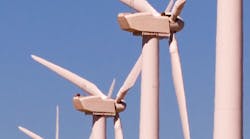I recently returned from a visit to my stepdaughter and family, who live in Hawaii on the island of Oahu. She has been living there for a few years, so my wife and I have visited her a few times now. She lives in a town called Haleiwa, which is on the North Shore of Oahu. The view of the hills to the south of the island is as beautiful as ever. However, the view of the hills to the north has changed.
Back in November, a company called First Wind completed construction of Hawaii’s largest wind farm, the Kawailoa Wind project. So when you look north from Haleiwa, you can see a bevy of wind turbines methodically turning in the steady Hawaiian breeze. I was kind of shocked to see these turbines—there are 30 of them—but was also delighted to see this marvelous example of the use of green energy.
The 69-MW wind farm is built on land owned by Kamehameha Schools near Haleiwa and is expected to generate enough electricity to power the equivalent of 14,500 homes on Oahu, and at full output it could meet as much as 10% of Oahu’s annual power needs, according to Boston-based First Wind. The wind farm uses Siemens 2.3-MW wind turbines.
Download this article in .PDF format
This file type includes high resolution graphics and schematics.
I asked if there had been any backlash on the island from people who might be upset with the change in view, but it seems not. I also searched for news stories about Hawaiians protesting the turbines. Again, I couldn’t find anything. Apparently, the project was developed with extensive input from the local community.
I asked my wife what she thought. “I think they’re great,” she said. “Haven’t windmills been dotting landscapes for a very long time?” Absolutely, I replied.
This wind energy project is not the first for Oahu. It’s actually the second and the seventh for Hawaii overall, which I had not realized.
Trouble In The Winds At Falmouth
Coincidentally, while watching TV during my trip, I caught a news segment about wind turbines that had been erected in Falmouth, Mass., in 2010. According to the report, the town had been in discussions about this installation since 2002.
Related Articles
• New Ways To Charge Up Your Mobile Devices
• CES Proves That 4G LTE Still Has A Long Way To Go
• Hurricane Sandy Reveals Technology’s Winners And Losers
It took so long to deploy not because of opposition to the project, but because the community wanted to take advantage of state and federal grants and incentive programs to make this energy source economically viable. While the community initially approved the project, now it wants to take the turbines down—at a considerable cost.
There are two main complaints, noise and health—not the change in a very scenic view. The Falmouth project, unlike the one in Hawaii, uses only two turbines. According to reports, they are Vestas V 82 1.65-MW commercial wind turbines. The Vestas Web site (www.vestas.com) no longer lists this model, but similar models are available.
With regards to noise, tests conducted by the Massachusetts Department of Environmental Protection revealed that sound levels from one of the two turbines exceeded the 10-dBA threshold that MassDEP defines as unacceptable under both high and low wind conditions.
The noise is not a constant sound, but more of an impulse sound like a swoosh. There’s also an inaudible low-frequency sound, called infrasound. Reported health issues have included headaches, vertigo, sleep interruptions, and ringing in the ears.
Add Fire To The Mix
While researching this piece and learning about the other wind turbine installations in Hawaii, I found that one of them is having problems that have nothing to do with health, noise, or scenic beauty. The other wind farm on Oahu, at Kahuku, experienced a fire last August, which was the second one in two years.
The fire occurred in a 10,000-square-foot battery warehouse, also a First Wind facility, where electricity is stored from the farm’s dozen wind turbines. The cost to rebuild is estimated at $8 million. As of the end of February, this wind farm had not resumed operations.
This file type includes high resolution graphics and schematics.

